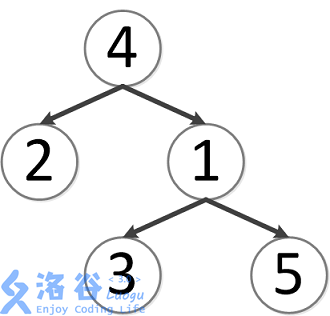题目来源:
https://www.luogu.org/problemnew/show/P3379
题目描述:
题目描述
如题,给定一棵有根多叉树,请求出指定两个点直接最近的公共祖先。
输入输出格式
输入格式:
第一行包含三个正整数N、M、S,分别表示树的结点个数、询问的个数和树根结点的序号。
接下来N-1行每行包含两个正整数x、y,表示x结点和y结点之间有一条直接连接的边(数据保证可以构成树)。
接下来M行每行包含两个正整数a、b,表示询问a结点和b结点的最近公共祖先。
输出格式:
输出包含M行,每行包含一个正整数,依次为每一个询问的结果。
输入输出样例
输入样例#1: 复制
5 5 4 3 1 2 4 5 1 1 4 2 4 3 2 3 5 1 2 4 5
输出样例#1: 复制
4 4 1 4 4
说明
时空限制:1000ms,128M
数据规模:
对于30%的数据:N<=10,M<=10
对于70%的数据:N<=10000,M<=10000
对于100%的数据:N<=500000,M<=500000
样例说明:
该树结构如下:

第一次询问:2、4的最近公共祖先,故为4。
第二次询问:3、2的最近公共祖先,故为4。
第三次询问:3、5的最近公共祖先,故为1。
第四次询问:1、2的最近公共祖先,故为4。
第五次询问:4、5的最近公共祖先,故为4。
故输出依次为4、4、1、4、4。
解题思路:
就是一个离线tarjan+并查集的,模板,关键就是处理query的id。。
代码:
#include <iostream>
#include <string>
#include <cstring>
#include <vector>
#include <queue>
#include <stack>
#include <algorithm>
#include <cmath>
#include <cctype>
#include <iomanip>
#define ll long long
const int maxn=500005;
using namespace std;
struct newt1
{
int to,next;
}e[maxn*2];
struct newt2
{
int id,to,next;
}query[2*maxn];
int father[maxn],ans[maxn],head1[maxn],head2[maxn],vis[maxn],cnt1,cnt2;
int n,m,S;
void addedge1(int u,int v)
{
e[cnt1].to=v;
e[cnt1].next=head1[u];
head1[u]=cnt1++;
}
void addedge2(int u,int v,int id)
{
query[cnt2].id=id;
query[cnt2].to=v;
query[cnt2].next=head2[u];
head2[u]=cnt2++;
}
int fi(int x)
{
if(x==father[x])return x;
return father[x]=fi(father[x]);
}
void init()
{
for(int i=1;i<=n;i++)father[i]=i;
memset(head1,-1,sizeof(head1));
memset(head2,-1,sizeof(head2));
}
void tarjan(int u)
{
vis[u]=1;
for(int i=head1[u];i!=-1;i=e[i].next)
{
int v=e[i].to;
//cout<<u<<" "<<v<<endl;
if(!vis[v])
tarjan(v),father[v]=u;
}
for(int i=head2[u];i!=-1;i=query[i].next)
{
int v=query[i].to;
if(vis[v]){
int z=fi(v);
ans[query[i].id]=z;
}
}
}
int main()
{
scanf("%d%d%d",&n,&m,&S);
init();
for(int i=1;i<=n-1;i++)
{
int a,b;
scanf("%d%d",&a,&b);
addedge1(a,b);
addedge1(b,a);
}
for(int i=1;i<=m;i++)
{
int a,b;
scanf("%d%d",&a,&b);
addedge2(a,b,i);
addedge2(b,a,i);
}
tarjan(S);
for(int i=1;i<=m;i++)
printf("%d\n",ans[i]);
return 0;
}